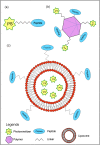Targeted Therapy of Cancer Using Photodynamic Therapy in Combination with Multi-faceted Anti-Tumor Modalities - PubMed (original) (raw)
Review
Targeted Therapy of Cancer Using Photodynamic Therapy in Combination with Multi-faceted Anti-Tumor Modalities
Malini Olivo et al. Pharmaceuticals (Basel). 2010.
Abstract
Photodynamic therapy (PDT) has emerged as one of the important therapeutic options in the management of cancer and other diseases. PDT involves a tumor-localized photosensitizer (PS), which when appropriately illuminated by visible light converts oxygen into cytotoxic reactive oxygen species (ROS), that attack key structural entities within the targeted cells, ultimately resulting in necrosis or apoptosis. Though PDT is a selective modality, it can be further enhanced by combining other targeted therapeutic strategies that include the use of synthetic peptides and nanoparticles for selective delivery of photosensitizers. Another potentially promising strategy is the application of targeted therapeutics that exploit a myriad of critical pathways involved in tumorigenesis and metastasis. Vascular disrupting agents that eradicate tumor vasculature during PDT and anti-angiogenic agents that targets specific molecular pathways and prevent the formation of new blood vessels are novel therapeutic approaches that have been shown to improve treatment outcome. In addition to the well-documented mechanisms of direct cell killing and damage to the tumor vasculature, PDT can also activate the body's immune response against tumors. Numerous pre-clinical studies and clinical observations have demonstrated the immuno-stimulatory capability of PDT. Herein, we aim to integrate the most important findings with regard to the combination of PDT and other novel targeted therapy approaches, detailing its potential in cancer photomedicine.
Keywords: anti-angiogenesis; immune response; nanoparticles; peptides; photodynamic therapy (PDT); targeted therapy; vascular PDT.
Figures
Figure 1
Design of photosensitizer conjugate: (a) peptides covalently attached to a photosensitizer via linker, (b) several peptides as well as photosensitizer molecules conjugated to a polymer scaffold, and (c) peptides covalently coupled to liposomes encapsulating PS.
Figure 2
(a) Vascular-targeting PDT (VTP) is performed when the PS is confined within the tumor vasculature. Following VTP, the sensitive sites within the microvasculature are damaged thus causing vessel constriction, blood flow stasis and thrombus formation that finally leads to tumor destruction. (b) PDT induced oxidative stress causes hypoxia within the tumor tissue that triggers the release of angiogenic growth factors that include VEGF, COX-2 and EGFR. These pro-angiogenic factors facilitate endothelial cell proliferation and migration thus initiating angiogenesis and tumor growth. Administration of angiogenic inhibitors that specifically target these growth factors in combination with PDT has shown to be effective in suppressing angiogenesis and preventing tumor regrowth.
Similar articles
- A tissue factor-cascade-targeted strategy to tumor vasculature: a combination of EGFP-EGF1 conjugation nanoparticles with photodynamic therapy.
Shi W, Yin Y, Wang Y, Zhang B, Tan P, Jiang T, Mei H, Deng J, Wang H, Guo T, Pang Z, Hu Y. Shi W, et al. Oncotarget. 2017 May 9;8(19):32212-32227. doi: 10.18632/oncotarget.12922. Oncotarget. 2017. PMID: 27793028 Free PMC article. - Vascular and cellular targeting for photodynamic therapy.
Chen B, Pogue BW, Hoopes PJ, Hasan T. Chen B, et al. Crit Rev Eukaryot Gene Expr. 2006;16(4):279-305. doi: 10.1615/critreveukargeneexpr.v16.i4.10. Crit Rev Eukaryot Gene Expr. 2006. PMID: 17206921 Review. - Immune response after photodynamic therapy increases anti-cancer and anti-bacterial effects.
Reginato E, Wolf P, Hamblin MR. Reginato E, et al. World J Immunol. 2014 Mar 27;4(1):1-11. doi: 10.5411/wji.v4.i1.1. World J Immunol. 2014. PMID: 25364655 Free PMC article. - The Role of Melanoma Cell-Derived Exosomes (MTEX) and Photodynamic Therapy (PDT) within a Tumor Microenvironment.
Mkhobongo B, Chandran R, Abrahamse H. Mkhobongo B, et al. Int J Mol Sci. 2021 Sep 8;22(18):9726. doi: 10.3390/ijms22189726. Int J Mol Sci. 2021. PMID: 34575889 Free PMC article. Review. - Photodynamic Therapy: Targeting Cancer Biomarkers for the Treatment of Cancers.
Wang X, Luo D, Basilion JP. Wang X, et al. Cancers (Basel). 2021 Jun 15;13(12):2992. doi: 10.3390/cancers13122992. Cancers (Basel). 2021. PMID: 34203805 Free PMC article. Review.
Cited by
- A Perspective of Epigenetic Regulation in Radiotherapy.
Peng Q, Weng K, Li S, Xu R, Wang Y, Wu Y. Peng Q, et al. Front Cell Dev Biol. 2021 Feb 18;9:624312. doi: 10.3389/fcell.2021.624312. eCollection 2021. Front Cell Dev Biol. 2021. PMID: 33681204 Free PMC article. Review. - Overview of Nanoparticle-Based Approaches for the Combination of Photodynamic Therapy (PDT) and Chemotherapy at the Preclinical Stage.
Menilli L, Milani C, Reddi E, Moret F. Menilli L, et al. Cancers (Basel). 2022 Sep 14;14(18):4462. doi: 10.3390/cancers14184462. Cancers (Basel). 2022. PMID: 36139623 Free PMC article. Review. - Drug Carrier for Photodynamic Cancer Therapy.
Debele TA, Peng S, Tsai HC. Debele TA, et al. Int J Mol Sci. 2015 Sep 14;16(9):22094-136. doi: 10.3390/ijms160922094. Int J Mol Sci. 2015. PMID: 26389879 Free PMC article. Review. - A Non-Invasive Deep Photoablation Technique to Inhibit DCIS Progression and Induce Antitumor Immunity.
Kaneko K, Nagata H, Yang XY, Ginzel J, Hartman Z, Everitt J, Hughes P, Haystead T, Morse M, Lyerly HK, Osada T. Kaneko K, et al. Cancers (Basel). 2022 Nov 23;14(23):5762. doi: 10.3390/cancers14235762. Cancers (Basel). 2022. PMID: 36497243 Free PMC article. - Biological Evaluation of Photodynamic Effect Mediated by Nanoparticles with Embedded Porphyrin Photosensitizer.
Žárská L, Malá Z, Langová K, Malina L, Binder S, Bajgar R, Henke P, Mosinger J, Kolářová H. Žárská L, et al. Int J Mol Sci. 2022 Mar 25;23(7):3588. doi: 10.3390/ijms23073588. Int J Mol Sci. 2022. PMID: 35408948 Free PMC article.
References
- Dolmans D.E., Fukumura D., Jain R.K. Photodynamic therapy for cancer. Nat. Rev. Cancer. 2003;3:380–387. - PubMed
- Fabris C., Valduga G., Miotto G., Borsetto L., Jori G., Garbisa S., Reddi E. Photosensitization with zinc (II) phthalocyanine as a switch in the decision between apoptosis and necrosis. Cancer Res. 2001;61:7495–7500. - PubMed
- Henderson B.W., Dougherty T.J. How does photodynamic therapy work? Photochem. Photobiol. 1992;55:145–157. - PubMed
Publication types
LinkOut - more resources
Full Text Sources
Other Literature Sources

